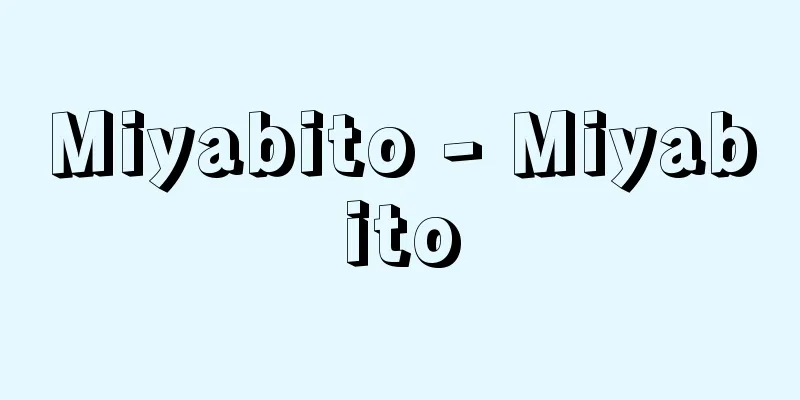Trust - Shintaku (English spelling) trust

|
A trustor transfers his/her property to a trustee who can be trusted, and has the property managed or disposed of for the benefit of a person designated by the trustor (beneficiary). Trusts are established by contract or will, and are divided into public trusts, which have religious, charitable, academic or other public interest purposes, and private trusts, which have personal interests as their objectives. They are also divided into business trusts and non-business trusts, depending on whether the trust is underwritten as a business or not. [Shoichi Asashima] historyThe origin of the trust is said to be the use that arose in medieval England. It was a system devised by the church and its believers to protect their own interests in opposition to the land control and taxation of feudal lords, and later developed into a general system of asset management and operation. In England, it was established that individuals accepted the trust as unpaid, non-business trusts, and with the custom of wills as a backdrop, the core business of trusts was estate management. When the trust system was introduced to America, it took the form of financial institutions undertaking asset management for individuals and corporations as a business, and trusts were divided into personal trusts and corporate trusts depending on the settlor, and trustees came to hold huge trust assets. The trust system is generally found in countries that belong to the common law system (Canada, India, Australia, etc.). Japan imitated the British and American trust systems, but initially, in connection with the introduction of foreign capital after the Russo-Japanese War, only the Secured Bond Trust Act (Act No. 52 of 1905, now renamed the Secured Bond Trust Act) was enacted. Later, as part of the development of the financial system, the Trust Act (Act No. 62 of 1922) and the Trust Business Act (Act No. 65 of 1922) were enacted, establishing the legal foundation for trust business in general, and trust companies emerged as the exclusive operators of trust business. [Shoichi Asashima] Japan's Trust SystemThe modern trust system includes principles such as separate management of the trustor's trust assets, dividends based on the results of management and investment, and the duty of care of the manager, but in Japan it has developed in a somewhat unique way. First, the Trust Business Act adopted a trusteeship format based on the type of property. In other words, it limited the types of property to seven types: money, securities, monetary claims, movable property, real estate, surface rights, and land lease rights, and did not allow the lump-sum entrustment of various types of property, as in the UK and the US (denial of the principle of inclusion). Secondly, the entrustment of money, especially the joint management of designated money trusts, developed to an extraordinary extent. This was because it was a financial product that was an exception to the principle of separate management, jointly managed various amounts of funds, and had a high yield with guaranteed principal. As a result, a unique Japanese trust industry was formed that was centered on accepting money for profit-making purposes, and was different from the British trust industry, which was centered on the disposal and management of inheritances, and the American trust industry, which was centered on the acceptance of securities. In other words, the Japanese trust industry, which had its business base on wealthy property owners and accumulated long-term, large, stable funds, had the characteristics of a long-term financial institution rather than an institution for managing and operating various types of assets. Even after the Second World War, the institutional framework for trusts established by the Trust Business Act was maintained, and within that framework, trust business was expanded. In other words, trust companies were permitted to operate banking businesses and transformed into trust banks, which made great strides with loan trusts (a type of designated money trust joint management) as their driving force, establishing a position as a long-term financial institution on a par with long-term credit banks, and also developing in the acceptance of securities investment trusts (specified money trusts) and pension trusts (solely managed designated money trusts) that play a part in social welfare. The number of trust users has increased to the masses, and has expanded significantly compared to the pre-World War II period when they were dependent on wealthy individuals, but the nature of the Japanese trust industry, which is primarily concerned with the acceptance of money, remains unchanged. Then, amid the wave of financial liberalization, from 1985 onwards, foreign banks entered the trust business, and banks and securities companies entered the business through subsidiary structures, breaking the monopoly of existing trust banks. Furthermore, the Trust Business Act was revised in December 2004, and the Trust Act in December 2006. This was the first major revision in 80 years, and it revised the laws to reflect the realities of the business and paved the way for the expansion of trust use. In other words, it marked a new era in the trust system by removing restrictions on assets that could be accepted, allowing the free development of the trust business, expanding the number of people involved in the trust business, and allowing entities other than financial institutions to enter the trust business. [Shoichi Asashima] "Trust Practice Courses," edited by the Trust Association, all 8 volumes (1962-64, Yuhikaku)" ▽ "History of the Development of the Trust Industry in Japan, by Asashima Shoichi (1969, Yuhikaku)" ▽ "Study of the Legislative History of the Trust Industry in Japan, by Asashima Shoichi (1980, Financial and Fiscal Affairs Research Institute)" ▽ "Various Operations of Trust Companies in the Prewar Period, by Asashima Shoichi (1995, Nihon Keizai Hyoronsha)" ▽ "Trust Banking Reader," edited by Mori Kazushichi (1973, Financial and Fiscal Affairs Research Institute)" ▽ "Trust Terminology Dictionary," edited by the Research Department of the Trust Association (1976, Toyo Keizai Shinposha)" ▽ "Study of the Legislative Process of Trusts, by Yamada Akira (1981, Keiso Shobo)" ▽ "The Age of Trusts: The Functions of Trusts and the Responsibilities of Trust Banks," edited by Hayashi Hiroshi (1991, Financial and Fiscal Affairs Research Institute, Kinzai Publishing)" ▽ "Q&A," edited by the Trust Business Research Institute 110 Points on Trusts (1992, Kinzai Publishing, Financial Affairs Research Institute) ▽ "Introduction to Trust Business - Easy to Understand with Diagrams and Illustrations" 5th Edition (2004, Financial Affairs Research Institute)" ▽ "60 Points on Trusts: Handbook of Trusts (2008, Kinzai Publishing, Financial Affairs Research Institute)" [Reference items] | | | | | | | | |Source: Shogakukan Encyclopedia Nipponica About Encyclopedia Nipponica Information | Legend |
|
委託者が自己の財産を信頼しうる他人(受託者)に譲渡し、自己の指定した者(受益者)の利益のために管理または処分させること。信託は契約または遺言によって設定され、宗教・慈善・学術そのほか公益を目的とする公益信託、個人的利益を目的とする私益信託に分けられ、信託の引受けを営業とするか否かで、営業信託と非営業信託とに区別される。 [麻島昭一] 歴史中世イギリスに発生したユースUseが信託の起源といわれる。教会・信者が封建領主の土地支配・課税に対抗して、自らの利益を守るために考え出した制度であり、のち一般的な財産管理運用の制度へ発展した。イギリスでは個人が無報酬の非営業信託として受託する形で定着し、遺言の慣習を背景に遺産処理が信託の中心的業務となった。アメリカに渡った信託制度は、金融機関が個人・法人の財産管理を営業として引き受ける形をとり、委託者によって個人信託・法人信託に分けられ、受託者は巨額の信託財産を擁するに至った。信託制度は概して英米法体系に属する諸国にみられる(カナダ、インド、オーストラリアなど)。日本は英米の信託制度を模倣したが、まず日露戦争後の外資導入に絡んで、1905年に担保附社債信託法(明治38年法律52号、現在は担保付社債信託法と改称)だけが制定され、のち金融制度整備の一環として1922年に信託法(大正11年法律62号)および信託業法(大正11年法律65号)が制定され、ここに信託業務一般の法的基礎が確立、信託会社が信託業務の独占的担い手として登場した。 [麻島昭一] 日本の信託制度近代的信託制度では、委託者の信託財産ごとの分別管理、管理運用結果の実績配当、慎重な管理者の注意義務などの原則を内包するが、日本ではやや特殊な発展を遂げている。第一に、信託業法は財産形態別の受託形式を採用した。すなわち、財産種類を金銭、有価証券、金銭債権、動産、不動産、地上権、土地賃借権の7種に限定し、かつ英米のように諸種財産を一括受託することを認めなかった(包括主義の否定)。第二に、金銭の受託、とくに指定金銭信託合同運用が異常なまでに発達した。その理由は、分別管理原則の例外をなし、大小さまざまな資金を合同運用し、元本を保証した高利回りの金融商品であったからである。 その結果、遺産処理・管理を中心とするイギリス信託業、有価証券受託を柱とするアメリカ信託業とも異なる、利殖目的の金銭を受託の中心とする日本独自の信託業が形成されたのである。別言すれば、富裕な財産所有者を営業基盤とし、長期大口の安定資金を集積した日本信託業は、諸種の財産の管理運用機関というよりは長期金融機関の性格をもった。 第二次世界大戦後も信託業法で定められた信託の制度的枠組みは維持され、そのなかで信託業務の拡大が図られた。すなわち、信託会社が銀行業務兼営を認められて変身した信託銀行は、貸付信託(指定金銭信託合同運用の一種)を原動力に大発展を遂げ、長期信用銀行と並ぶ長期金融機関の地位を確立、証券投資信託(特定金銭信託)の受託、社会福祉の一環を担う年金信託(指定金銭信託単独運用)でも発展した。信託の利用者は大衆化し、大口財産家に依存した第二次世界大戦前と比較して著しく拡大したが、金銭の受託を主とする日本信託業の性格は依然として不変である。 そして金融自由化の波のなか、1985年(昭和60)以降外資系銀行の信託業参入や、銀行・証券会社などの子会社方式による参入が相次ぎ、既存信託銀行の独占は破られた。さらに信託業法は2004年(平成16)12月、信託法は2006年12月に改正された。それは80年ぶりの大改正で、実態にあわせた見直し、かつ信託利用拡大の道を開くものであった。すなわち、受託可能財産の制限を撤廃して、信託事業の自由な展開を可能にし、信託業の担い手を拡大し、金融機関以外の信託業参入を認めるなど信託制度に新紀元を画した。 [麻島昭一] 『信託協会編『信託実務講座』全8冊(1962~64・有斐閣)』▽『麻島昭一著『日本信託業発展史』(1969・有斐閣)』▽『麻島昭一著『日本信託業立法史の研究』(1980・金融財政事情研究会)』▽『麻島昭一著『戦前期信託会社の諸業務』(1995・日本経済評論社)』▽『森一七編『信託銀行読本』(1973・金融財政事情研究会)』▽『信託協会調査部編『信託用語辞典』(1976・東洋経済新報社)』▽『山田昭著『信託立法過程の研究』(1981・勁草書房)』▽『林宏編『信託の時代――信託の機能と信託銀行の責務』(1991・金融財政事情研究会、きんざい発売)』▽『信託業務研究会編『Q&A 信託110のポイント』(1992・金融財政事情研究会、きんざい発売)』▽『経済法令研究会編『信託業務入門――図とイラストでよくわかる』5訂版(2004・経済法令研究会)』▽『トラスト60編『ハンドブック 信託』(2008・金融財政事情研究会、きんざい発売)』 [参照項目] | | | | | | | | |出典 小学館 日本大百科全書(ニッポニカ)日本大百科全書(ニッポニカ)について 情報 | 凡例 |
<<: Oracle - Shintaku (English spelling) Oracle English
Recommend
Cajeput oil - Cajeputeyu
…The oil obtained by distilling the branches and ...
"Kasuga Kaishi"
...Many waka poems have been written on the "...
Onania - masturbation
... The repression of sexuality by Christianity h...
Convexing mixing
…[Kazuo Yamamoto]. … *Some terminology explanatio...
Nísos Kérkyra (English spelling)
...area: 593 km2 , population: 97,000 (1981). The...
Five oranges - five oranges
...It is said that the Nichiren sect uses the man...
Bulgakov, SN (English spelling)BulgakovSN
...Struve was considered a representative Marxist...
Matteo da Bascio
…The name comes from the pointed cap (capuccio) w...
Adam Malik
1917‐84 Indonesian politician. Born in Pumatan Sia...
ALU - A.L.U.
《 arithmetic logical unit 》⇒Arithmetic unit Source...
Later Hojo Clan
The origins of the Ise Naga clan, the founder of t...
Adiantum hispidulum (English spelling) Adiantumhispidulum
…[Shigeyuki Mitsuda]. … *Some of the terminology ...
Preganglionic fiber
In the autonomic nervous system, the preganglionic...
kadalī (English spelling) kadali
…In addition to eating it raw, it is also used to...
Ageo-juku
…The recreation centers include Ageo Sports Park ...









